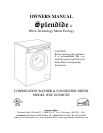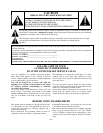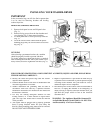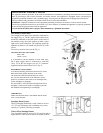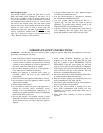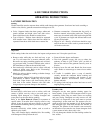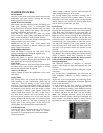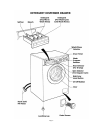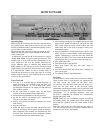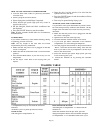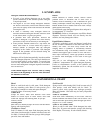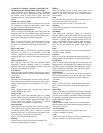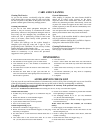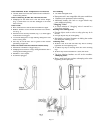
CARE AND CLEANING
Cleaning The Exterior
As you use the washer, occasionally wipe the cabinet
with a damp cloth or sponge; wipe dry with a soft clo
th.
Do not use polish or any kind on the plastic trim. Some
polishes contain agents which may damage plastics.
Cleaning The Int
erior
If you live an area where phosphate detergents are
banned, it may be necessary to recondition the washer
periodically. Bec
ause a non
-
phosphate detergent must be
used, body oils and detergent may accumulate in the
washer tub. This is particularly evid
ent in hard water
areas or in homes, where heavily soiled garments are
regularly laundered.
To remove this build
-
up,
run the washer through a
co
m
plete cycle using hot water and 2 cups of a non
pr
e
cipitating water conditioner. Do not add any clothes,
laundry detergent or other laundry aids.
Once all accumulation has been re
moved, your laundry
should be satisfactory if you follow the preventive
su
g
gestions in this guide
-
book.
General Maintenance
After washing is complete, the water faucets should be
turned off to relieve water pressure on the hoses.
Wi
pe the inside of the washer door with a soft cloth to
remove any remaining moisture. Periodically, a thin coat
of paste wax shou
ld be applied to the inner door of the
washer; especially to the area which is immediately next
to the door window.
This will p
rotect the door finish from laundry aid spills
and any discoloration which may results from these
spills.
The interior of the machine should be cleaned period
i-
cally by qualified service personnel.
A internal condenser cleaning kit is available to improve
drying time when needed (Part #
100A).
Cleaning The Drain Screen
Clean the drain screen frequently. For instruction please
refer to page 7 of this manual.
WINTERIZING
•
Turn off the hot and cold water source to machine.
•
Set machine to fill in regular cycle on warm wash.
•
Turn machine on for a fe
w minutes so machine can
take on any water.
•
Lift inlet hoses to assure no water is left in inlet hoses.
•
Turn unit off.
•
Advanc
e the wash timer to spin cycle and turn on.
This will activate the water pump and will evacuate as
much water as possible.
•
Turn unit to off.
•
Place a towel under the drain filter area and remove
drain filter. This will drain any water left in the bottom
of unit.
•
Install drain filter correctly to assure it does not leak
water.
•
In extreme conditions you may wish to completely
remove the inlet hoses.
•
Complete
Washer Does Not Start
•
Washer may not be plugged in or connection may be
loose.
•
House fuse blown or circuit breaker tripped.
•
T
imer knob not in correct position.
•
Cycle selector knob not in correct position.
•
Door is not securely shut.
Washer Stops During
Cycle
•
Drain hose is kinked or clogged (Fig. 1).
•
House fuse blown, circuit breaker tripped, or wall plug
not firmly in receptacle.
•
No more than 6" of the drain hose should insert into a
standpipe.
•
The outlet end of the drain hose
must be at least
20" (50 cm) above the base of the machine.
•
Assure an air break is available to prevent the machine
from siphoning in a standpipe.
•
The standpipe should be at 25" (62 cm) m
inimum
34" (86 cm) maximum height.
•
Assure the drain loop or suitable clamp to support drain
hose has been used.
Water Does Not
Enter The Washer, Or It Enters
Slowly
•
Water supply is not adequate in the area.
•
Hot and cold water faucets for the inlet hoses
are not
turned completely on.
•
Water is being used elsewhere in the house, when the
washer is running.
•
Water inlet hose filter
are clogged (Fig. 3).
•
Water inlet hoses are kinked.
AV O I D
-
SERVICE CHECK LIST
You may save the cost and inconvenience of an unnecessary service call by first reviewing this easy
-
to
-
use check list
of the most frequently encountered situations that are not the result of defective workmanship or materials.
You
will be charged for a service call while the appliance is in warranty if the problem is not caused by
defective workma
nship or materials.
Review this
Avoid
-
Service Check List
before calling for service. It may save time and expense.
Page 13



